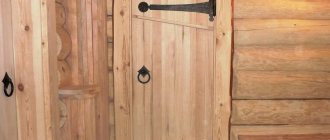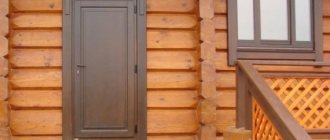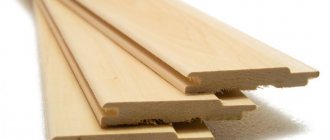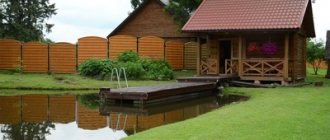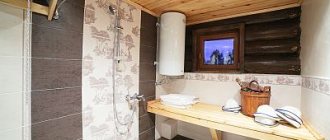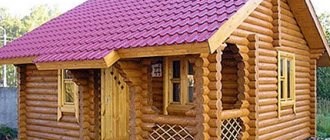The minimum set is one entrance door to the bathhouse and a second one for the steam room. The entrance must provide good thermal insulation. The general requirements there are the same as for an apartment or house. To enter a steam room, the requirements for heat resistance and resistance to high humidity come first. The remaining selection criteria are the same as for conventional entrance or interior doors. These are the overall dimensions of the canvas, its material, fittings, design and price. All this deserves separate study.
How are they different from regular ones?
Doors for baths are presented in a separate special category in almost all stores. The main differences are in materials and design. The classic paneled design is not appropriate in a bathhouse. It can be seen rarely, but another technology is used - door leaves for bathhouses made of solid wood.
Important! Another feature that can also only be seen in a bathhouse is unpainted and unvarnished wood. Indoors it retains its natural color for quite a long time. If it needs to be preserved longer and there are special requirements for it, then a safe water-based varnish (water-resistant compound) is used.
Choosing the right material
The choice of material depends on the planned result. If the output should be a paneled door, then you need to purchase bars for the frame and frame. And for the door leaf you should buy a board whose thickness is about 40 mm.
The next question the bathhouse owner will ask is: how much material will be needed? It depends on the type of building and the number of doors. For example, for a medium-sized bathhouse, as a rule, three doors are made, but for a smaller building, two will be enough.
The standard size of entrance systems is 600-700 mm by 1700-1800 mm. But it’s better to buy a little more material: this way, if you find yourself in an unforeseen situation, no one will have to be nervous and rush to the hardware store. Choosing the board itself is quite simple.
Here is a list of characteristics it should have:
- Dryness. The material must be dry, humidity - no more than 12 percent.
- Purity. Make sure there is no rot, mold or mildew on the boards.
- Smoothness. It is better not to buy wood with visible knots, as they will fall out during processing and the quality of the material will suffer.
Wooden entrance doors for bathhouses
Among the materials for a bathhouse, wood is unrivaled. An entire bathhouse can be built from wood alone. This natural material has no disadvantages in terms of environmental friendliness and safety for humans. It is also advantageous in terms of price, but it also has some disadvantages. These are fragility, combustibility and instability to water.
Therefore, in modern baths, wood is used only for interior decoration; wooden sauna doors are also very popular. Foundation, roofing, waterproofing - all this is made only from durable inorganic materials, such as concrete, metal and polymers. For doors, the type of wood from which they are made is of great importance.
Wood species
When assessing which doors to a bathhouse are best, you need to pay attention to the types of wood. The construction of wooden baths has been going on since ancient times, and during this time the best wood species were selected and tested. Various woods were rated for resistance to water, degree of swelling and strength. An important factor is the release of aromatic substances when heated. In first place for these qualities is linden and aspen wood.
Information. Aspen is an affordable wood for doors to a paired compartment. The wood withstands moisture well and has a pleasant white color. Linden doors for baths are the best. This is an option that can often be seen in luxury baths. The doors to the linden steam room look very elegant thanks to the bright color of the wood.
Information. Conifers, due to the presence of resinous substances, also have good resistance to water. Of these, the cheapest option is pine. Pine doors for baths and saunas will have a minimal cost, but this breed has many disadvantages. It dries out and cracks a lot. In addition, the structure has sparse layers (a large distance between the growth rings). Pine canvases are protected with varnish or paint. They are not used in their pure form due to these disadvantages.
A good option among conifers is cedar and larch. In many regions, they are not much more expensive than pine, and the appearance and strength of these species are much better. Canvas made of cedar and larch simply sand well and need not be covered with anything.
Tree selection
For many centuries, the bathhouse has been considered a place where not only the body, but also the soul is cleansed. It all started back in the days of ancient Rus', when someone discovered the wonders of a wooden bathhouse: they say, you get younger and don’t know diseases. Whether it is true or not, a wooden bathhouse has become not just a place to get rid of illnesses, but also almost a mandatory building on a summer cottage. And here it is not its healing properties that are important, but the material from which it was created.
The owner of the house, having decided to start building a bathhouse, will certainly think: what kind of wood to choose? Each of them has its own beneficial properties: pine needles are known to calm the nerves, and linden treats colds. But, in addition to health factors, you should also think about practical qualities.
Each type of wood has its own service life and other characteristics. One tree will last a century, another will become a breeding ground for bark beetles in a month. Often, during the construction of wooden houses or baths, linden is preferred. Moreover, this applies not only to the building itself, interior decoration, but also to entrance systems. Why do they prefer to make bath doors from linden? We'll find out now.
Manufacturing technology
Wooden entrance doors for bathhouses are made using classical carpentry technology. An economical design option for the entrance door is a paneled frame filled with a wooden board. OSB boards can be used instead.
If the first thing you need is environmental friendliness and safety of the material for humans, then you should prefer only solid wood panels. They are ideal for couples. The option with OSB board is more common and cheaper. It is also well suited for use at the entrance to the bathhouse.
Attention! Wooden sauna doors made according to a paneled design are not classic. Another classic option would be to simply connect the boards with crossbars. Such canvases are practically not used as entrance and interior walls for apartments. Baths are the only area of their use now.
The best materials for entering the bathhouse
Modern bath boxes are increasingly being built according to standard designs from standard materials. Most often, the designer suggests that the future owner install cedar doors at the entrance. The cost of a door leaf made of cedar tongue-and-groove boards is almost three times higher than that of a pine assembly.
Entrance to the bathhouse made of cedar planks
What cannot be taken away from cedar is the beautiful texture of the wood. Cedar canvas can be maintained well for one and a half to two decades in outdoor conditions, but you can only overpay for the sake of beauty if the cedar entrance doors act as a status element of the expensive interior of the bathhouse.
One of the advantages of cedar boards as a material for the front door and door is that the wood, even with strong moisture and heat, is practically not subject to warping. At the same time, cedar doors for a bathhouse, when in contact with hot air, begin to sweat resins and resin, just like fir, pine or larch.
If funds allow, then it is best to make wooden doors for a bathhouse from oak, the price is almost the same, and the service life is twice as long. True, the texture of oak is clearly inferior in the beauty of the pattern of polished cedar.
Pine door panels at the entrance to the bathhouse
Most professional designers involved in the planning and layout of wooden baths do not perceive solid pine and boards at all as a material for the front door. And completely in vain.
In decorative terms, pine and spruce wood looks average, the fibers are mostly straight and of different thicknesses. The only drawback of pine boards is the large number of knots and defects, therefore, in order to select high-quality material for making a wooden door for the entrance to the bathhouse, you will have to go to a sawmill or a company.
Pine and especially spruce wood without treatment quickly acquires a dull gray appearance, so a modified board is used for finishing. Most often, for wooden doors to a bathhouse, pine boards are bleached in hydrogen peroxide, then artificially painted with chestnut or cedar toner and saturated with polyethylene vapor in a chamber, after which the material acquires the water resistance of plastic. With the help of inexpensive processing, a pine board can even be made to look like rosewood or sandalwood, but against the background of a pine or oak facade of a bathhouse, an entrance panel with a similar pattern will look slightly out of place.
Pine is not suitable for interior decoration of wooden walls of a bathhouse, especially a steam room. Even at moderate temperatures, the oleoresin sublimes, and as a result, the steam room is saturated with the smell of rosin and tar for a long time. The only thing worse could be a steam room made of birch or larch.
Fans of pine aromas claim that after two to three weeks of using the sauna, the smell of pine in the steam room is barely noticeable.
Entrance doors made of other types of wood
To make wooden doors to a bathhouse, it is not necessary to make them from an array of expensive wood species. The old proven method of assembling a door leaf from a profiled strip is recognized as one of the most successful options for constructing a wooden bathhouse door.
Roughly the same result can be achieved in a simpler way:
- The wooden door at the entrance to the bathhouse is assembled on a frame base; if it is necessary to increase the heat-insulating properties, then two frames made of treated pine or larch are sewn together, between which a vapor barrier film is laid;
- The outer surface is lined with clapboard made of cedar or any other durable wood; the inner lining can be made from the remains of linden or even aspen.
The door turns out to be quite voluminous and, at first glance, massive, but in fact its weight is 30-40% less than that of a door leaf assembled from solid wood.
Plastic
The plastic door to the bathhouse is made from a PVC profile made using the same technology as conventional metal-plastic windows. The advantages of this material are best assessed in comparison with wood. The most important of them are quite obvious. This is the invariability of shape and geometric dimensions.
This fabric has seals around the perimeter, providing excellent thermal insulation qualities. They can be multi-row. It is ideal as an entrance, but it cannot be used for a steam room.
Information. The entrance door to a bathhouse made of PVC plastic will be light, strong and durable. It will not creak, and the lightweight hollow fabric with insulation closes silently without popping. Designers offer a huge number of options here.
Usually a simple, unpretentious door is installed in a bathhouse at a summer cottage. In appearance, it is very similar to those ordinary canvases that are used as entrances to apartments.
Modern bathhouses with several rooms require several doors: entrance, steam room and interior.
Plastic for interior doors in a bathhouse can be successfully used. PVC plastic is not intended for high temperatures. That is why it is completely unsuitable for a steam room.
There are special options made of heat-resistant plastic, but they are very rare and are used mainly for design reasons.
Glass
Information Glass is an excellent environmentally friendly and heat-resistant material. Doors for saunas are often made of glass. They look fashionable and expensive. These are discussed in detail in another article on this site.
Wooden sauna doors
Wood is the most favorable material for a bathhouse. Although quite capricious. Everyone knows that wooden sauna doors often “lead,” that is, they become deformed due to humidity and no longer fit into the doorway. Another problem is wood cracking
Be that as it may, this does not prevent many bathhouse owners from installing such doors both at the entrance and between rooms. Moreover, there are different types of wood, and their qualities vary quite a lot.
By wood species
All species used in construction and interior design are divided into deciduous and coniferous . The latter contain a large amount of resin , which, on the one hand, protects the wood well from rotting and other troubles, on the other hand, the release of this resin to the surface when heated is unpleasant. And for sauna doors, coniferous wood is not suitable at all - you can get a severe burn from hot resin.
IMPORTANT! In a Russian bath, any type of wood can be used - deciduous and coniferous; in a sauna - only deciduous.
Resin is not the only criterion influencing the choice of wood. Craftsmen have long noticed that some rocks are more susceptible to moisture, others less. It is believed that minimal deformation is characteristic of linden , which is why it is often called the best material for a bath door. Well, let's see if that's true.
Bath doors made of linden
Photo: bath door (linden)
In fact, wood that is used in a humid and hot atmosphere has more requirements than just maintaining its dimensions. Although for the door to remain in the same dimensions is probably the most important thing.
However, wood differs from one another in its resistance to decay, strength, hardness, and wear resistance.
Linden is a species with low hardness (easily cut with a knife), strength and wear resistance (not used in construction, only in decoration). It also has low rot resistance .
BUT! It almost does not warp or dry out, and when exposed to moisture, it almost does not gain moisture and does not deform. In addition, it holds heat better than pine or larch.
This makes it a suitable material for finishing baths and saunas. First of all, these are linden bathhouse doors, but you can also use linden lining.
From the Caucasian linden
It often happens that people who are well versed in their business prefer materials produced strictly in a certain area. However, we don’t know whether this rule applies to the Caucasian linden tree or is it just a PR move by Krasnodar sellers.
It is assumed that trees that grew in the Caucasus differ from linden grown in other regions of Russia in that they are more resistant to decay and have higher quality wood.
Regarding quality, maybe, but the end consumer doesn’t care too much about this. After all, he buys sorted wood, and it must meet the standards. Therefore, whatever variety you take, this is the quality you get.
As for rotting... Well, we thought. On the one hand, anything can happen, which means that the Caucasian linden may turn out to be a species more resistant to decay than others. On the other hand, it does not become, say, an iron birch, but remains a linden tree. And this species, in principle, is characterized by low resistance to decay. That is, one cannot expect fundamentally different qualities from her, no matter where she grows up.
Therefore, focus on the manufacturer who offers quality products near you. But if they offer you, say, doors for a bathhouse made of Caucasian linden much more expensive than those from the same Yoshkarolinsk or some other, think again - what is qualitatively better about it?
From the array
Since the door can be made from a frame covered with clapboard, or from an array, that is, a shield - boards of significant thickness glued together, or even from a solid cut, the question arises, which one to prefer?
If you have a choice and finances allow, take bathhouse doors made of solid linden. Still, the array lasts longer and looks better.
Doors for baths made of aspen
Another species of deciduous tree that is often used in the bathhouse. In terms of resistance to rotting, it is very close to linden (that is, it is easily susceptible ), its hardness is average.
But aspen behaves well in water - its use in creating well log houses speaks for itself. When drying, aspen warps a little and is not prone to severe drying out.
ADVICE! It is permissible to make not only doors for a bathhouse from aspen, but also shelves - they are not so hot at high temperatures, and other finishing, but only finishing!
And, by the way, if the attitude of the Finns means something to you, then they are happy to use aspen as a material for the door frames into which they insert their glass door leaves for the bathhouse. Glass doors are in demand for steam rooms and saunas; separate articles about them offer complete information.
Cedar doors for baths
First, let's be clear: the cedar that is easy to find on sale at a reasonable price is not at all the same tree that was once sent to King Solomon for the construction of the temple. That is, a completely different look. Both are coniferous, but one is rightly called cedar, and the second is cedar pine. We sell (unless otherwise stated) cedar pine.
Not a bad tree for construction. Physical and mechanical properties are average between spruce and fir, but if we talk about resistance to rot, then it is higher than that of spruce and fir . But cedar pine holds fastenings a little worse than ordinary ones.
ON A NOTE! In a bathhouse, it is important that cedar pine is resistant to moisture and temperature changes. And also the fact that it is coniferous and will release resin in the sauna and for those who like a hot bathhouse. But, judging by the reviews, the resin does not release for long.
In general, water absorption in conifers is not that great. And they have less warping than most hardwoods. Cedar doors for a bath can be installed for the sake of their beautiful texture, pleasant smell and destruction of bacteria. But this also applies to ordinary pine.
Bath door made of solid pine
In Russia, 15% of the forest is pine. This is a fairly large number, so pine wood is very accessible and cheap. But is it worth making a bathhouse door from solid pine for this reason? Indeed, in this case there will be plenty of resin inside such a door.
Wooden steam room door made of softwood - pay attention to resin stains
We believe that it all depends on the bathing preferences of the owner . If you have a purely Russian bathhouse, that is, the temperature varies from 45 to 65 (with high humidity), then you should not be afraid of burns from the resin. This only affects sauna lovers.
But we were talking about the door to the steam room. And there are others in the bathhouse. And here it’s worth remembering that conifers have a lot of advantages - they don’t rot, they smell good, and pine in particular has high strength, low thermal conductivity and other advantages .
ADVICE! Many people have linden or aspen in their steam room, and pine in other rooms.
By type of lumber
Not all of the existing door structures are suitable, for example, for a door to a steam room, but no special structures have been created for a bathhouse. In other words, these are the same interior and exterior doors as always. And they can be made from solid wood or on a frame with filler (panelboard).
We will not consider the use of doors made of MDF, fiberboard and other similar materials in the bathhouse.
Solid wood bath doors
An array is when the thickness of the door matches the thickness of the used board made of boards.
Bath doors: solid pine
It goes without saying that with a minimum width of 60 cm, the shield will have to be assembled from several boards. Conventional furniture panels are held together with glue, but in a bathhouse it is better to use a tongue-and-groove joint without glue. At least in the steam room. Separate articles are devoted to the dimensions of doors for baths and the dimensions of cloths for steam rooms.
A classic craft or home-made bath door made of solid wood is a door with an “iglitsa”, that is, assembled onto a wedge, which is called an “igloo” or “butcher’s room”.
Here is a video demonstrating the process of creating such a door.
However, you don’t have to do everything yourself - there are plenty of standard solid wood doors on sale that can be installed in a bathhouse. We were curious - they cost very moderately, they look right . Mainly solid linden and pine are offered.
Here is another video where you can see some improvements against door swelling, as well as how an insulated wooden door can be. A separate article is devoted to the topic of door insulation.
Door to the bathhouse made of clapboard
Lining is a finishing material. It is used for upholstering walls, but if desired, it can also be used to cover a frame door.
The principle of a frame door is simple: a frame is assembled from timber to size according to this example) scheme:
A mandatory element is a vapor barrier - foil, for example, or film. It is attached to the frame. But filling voids with heat insulator is a controversial issue. In any case, we would not recommend using mineral wool if it is not intended for baths and saunas. By the way, if it gets wet, it will lose its insulating properties.
ADVICE! If you want to install insulation, choose one that will not release harmful chemicals when heated. In general, you don’t have to put a heat insulator in the steam room.
Well, when the base is ready, all that remains is to fill the lining on both sides. Similar doors are available for sale in finished form.
Entrance door to the bathhouse
There are fewer specific requirements for entrance doors for bathhouses. There you can use almost any option that is widely sold for apartments, but there are still some features.
So, for bathhouses made of logs or lined with imitation logs, a door of the appropriate design style is used. This is a canvas assembled from boards and reinforced with external crossbars and jibs.
This product has the trade name “bath door”. This design option is well suited for both the entrance and the paired compartment. With the same structural design, a large gap is left in the steam room, which is necessary for the wood to swell. Also, there are never any plastic seals on it.
What to make the entrance to the steam room from
The wooden door leaf for the entrance to the steam room is made mainly from hardwood, very rarely from treated cedar, and almost never from young coniferous wood. No one wants to touch with their hands the drops of resin and resin that sweat on the wooden cladding when trying to open the door and leave the steam room. Therefore, internal doors for bathhouses are made from linden or aspen. More expensive ash and chestnut are used for wall cladding and wooden furniture.
Advantages of linden doors
The structure of linden has slight differences from other most common species. Linden has a developed network of surface microcapillaries filled with air. The thermal conductivity of linden is significantly lower than that of pine, ash or oak, therefore, if you touch a wooden door lining heated in a steam room with your hand, it will not seem as hot as in the case of oak or cedar trim.
Linden fibers are quite thin, the material itself is very soft and easily deformed. Therefore, even with strong heating, linden steam room doors will never jam or become deformed. In addition, it is enough to simply insert heat-resistant glass into a linden door leaf; even with severe overheating, the glass insert will not burst.
The main disadvantage of linden is the poor durability of the material. A wooden door lined with linden must be thoroughly dried and conditioned; any puddle under the door can lead to rotting of the finish.
A wooden entrance block for a steam room is never made in the form of a single solid mass or sheet of tongue-and-groove boards. Most often, an oak frame with insulation is sheathed with linden clapboard, this allows you to effectively insulate heat and ventilate moisture from the door leaf.
Aspen door leaf
Aspen wood has characteristics similar to linden. A light, soft and at the same time well-insulated material is much cheaper than linden, so aspen doors are not inferior in popularity to linden.
Aspen is classified as a soft and low-strength species, so frames or boxes are never made from it. Unlike linden, the structure of aspen has huge pores, so the surface without treatment quickly loses its light background and darkens.
Aspen doors for bathhouses withstand strong moisture and condensation; the lining, even in its untreated form, practically does not rot, warp or deform, so it is ideal for the steam room of a small apartment bathhouse.
Accessories
All fittings must meet moisture resistance requirements and comply with the overall design style. The minimum set of fittings is hinges and door handles for the bathhouse. There is also a lock at the entrance to the bathhouse.
There are no special options for locks. Install regular door locks. Usually a bathhouse is built on a fenced area, so a lock is not necessary. Bathhouses with expensive interior decoration almost always have it.
On a note. If the interior is decorated with wood from floor to ceiling, then wooden door handles for a bathhouse are well suited. Plastic ones are very common, less often metal ones. The best hinges for sauna doors are brass or stainless steel. Ordinary steel ones should not be used, as they will quickly rust.
The fittings are fastened with self-tapping screws. Now they are all made either with galvanizing or phosphating. Their corrosion resistance in high humidity is quite acceptable.
If you buy a whole door block for a bathhouse ready-made from a company, then all the fittings are usually already included. There is no additional need to purchase it. This can be done if you have a better set of fittings, or to change the appearance, adjusting it to the overall style of decoration.
Metal doors for baths: outdoor
It is clear that if iron doors to the bathhouse are installed, then only at the entrance. There are no other options. But there are enough options for what exactly this metal bath door will be.
We believe that no one will install class 4 protection on a backyard bathhouse, but still, even in class 1 protection there is plenty to choose from Chinese and Russian models, which are quite inexpensive, by the way.
Metal doors for a bathhouse and not for a bathhouse are constructed in approximately the same way: they are a metal frame made of a profile , reinforced with stiffening ribs. This is a door frame that is covered with sheets of metal. After this, loops are placed. The second part of the kit is the door frame. It can be closed (O-shaped) or open (U-shaped), that is, with or without a threshold.
Steel sheets that are welded to the frame differ not only in thickness, but also in quantity. There can be from one to three, and one of the sheets can stand in the internal space.
The frame is usually not empty - it is filled with heat insulators . Most often mineral wool or polyurethane.
There are also various devices for protection, but we are talking about a bathhouse, so we should mention the most common problem with a metal entrance door condensation appears on the inside of it , which causes the iron to rust.
The main way to combat condensation is to install a second door . Either right there, practically in the same opening, or through the space of the vestibule (some have more, some have less).
Although you can make the casing - from clapboard or plastic.
BY THE WAY! The outside of such a door should also be lined with clapboard, so as not to accidentally stick to it in the cold.
Just don’t put a cheap apartment door on the street, otherwise it will be like in the video below.
https://youtu.be/ZbfCMg_2QJs
+++
There is definitely no better choice of interior and entrance doors in a bathhouse. There are restrictions within which we choose something. But this gives a certain freedom. So put what you like.
Which one to put in the steam room
Important! Here you need to install only special bath doors. No universal options will work due to the lack of sufficient heat and moisture resistance. For a door to a steam room, the best, and probably the only popular material is wood. The choice of breeds was discussed above. These are aspen, linden, larch. Pine is used quite rarely, only in the most budget options.
The most common option before and now for a steam room door is a plank panel fastened with overhead jibs and nails (the most classic bath door). The design is practical, but does not look very good.
The fact is that nails very quickly begin to oxidize and leave rusty stains on the wood. This issue can be completely eliminated by using modern stainless fasteners, as well as dowels. This is what modern enterprises do, even in the middle price segment. Canvases crudely nailed together are rare.
In the steam room, to save heat, openings of reduced height were previously widely used. You had to bend over to get through them. Nowadays, such a solution is almost never used and all doors to the paired compartment are of the usual size. However, in compact country baths they still use small openings to the steam room.
Attention! In the steam room, people are exposed to high air temperatures. For safety reasons, no bolts or latches are placed on the door. A viewing window is also often equipped .

